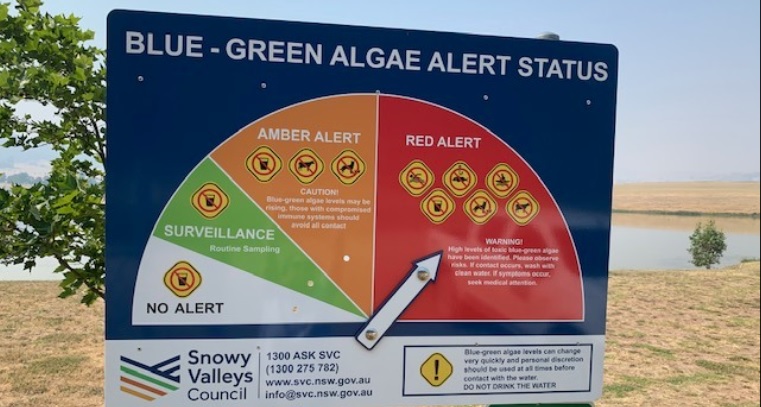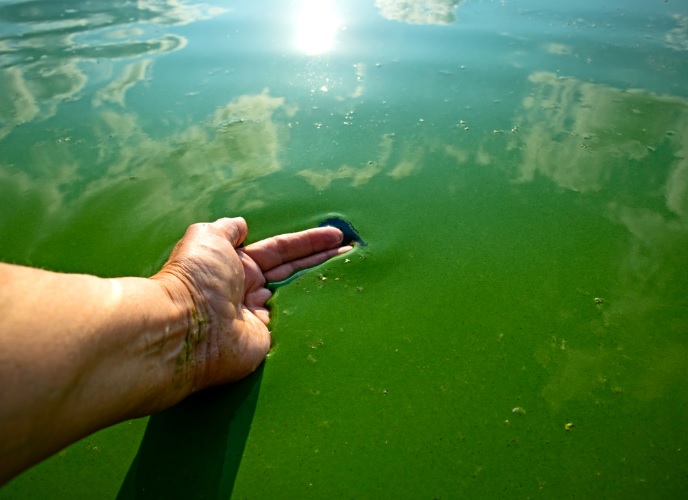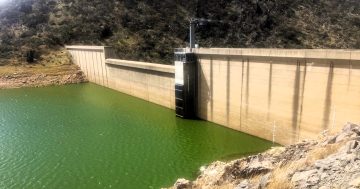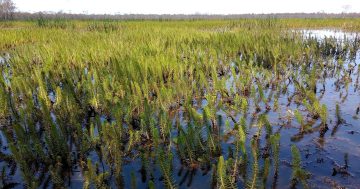
A red alert for blue-green algae has been issued by Snowy Valleys Council at the popular recreational fishing spot Mannus Lake, near Tumbarumba. Photo: Snowy Valleys Council.
Snowy Valleys Council has issued a blue-green algae red alert for Mannus Lake, with warning signs in effect at key recreational areas around the site.
According to the council, red-alert levels represent ”bloom” conditions whereby the algae may appear green or yellowish brown and is visible as clumps or scums.
It may also emit strong, musty or organically polluted odours.
The ”blooms”, says the council, should be considered toxic to humans and animals; therefore, the water should not be used for drinking (without treatment), stock watering or recreation.
People are also urged not to enter the water or bathe in water drawn from the lake or creek while the red-alert level warning is in place.
This warning also affects pets and livestock.
Exposure to high levels of blue-green algae and their toxins can cause diarrhea, nausea or vomiting; skin, eye or throat irritation; and allergic reactions or breathing difficulties.
Livestock owners should monitor stock water supplies and remove any stock from waters where surface scum is visible or blue-green algae are suspected.
Contact with affected water can cause skin irritation, mild respiratory effects and hay fever-like symptoms. Ingesting toxins can cause gastroenteritis symptoms, such as vomiting, diarrhoea, fever and headaches.
Toxins can also have an effect on the liver and the nervous system.
Mannus Lake, four kilometres west of Tumbarumba, is a popular location for recreational fishing, boating, walking and birdwatching, attracting tourism and economic benefits to the area.
Surrounded by pastoral holdings, significant nutrient-rich runoff into the dam combined with the still/slow-flowing water also makes Mannus Lake a blue-green algae breeding ground.
Decomposing algae can also cause depletion of oxygen and induce fish kills.
This is particularly significant for endangered Macquarie Perch habitats and populations.
At one time, Macquarie Perch was one of the most abundant native fish in the Murray-Darling system but, according to a 2018 NSW government assessment of the species, the building of dams and weirs had compromised spawning areas and blocked the fish’s movement.

The presence of blue-green algae has particular implications for endangered Macquarie Perch populations downstream of Mannus Creek. Photo: NSW DPI.
Overfishing, pollution and predation by introduced species such as redfin perch have also caused numbers to plummet.
The Mannus Creek population is highly significant as one of the four remaining populations of Macquarie Perch in NSW, the only remaining population in southern NSW and the focus of much ongoing research and management since its discovery in 2017.
The last known sighting had been eight years prior, in 2009.
Then, with the species almost decimated in the 2019-2020 Black Summer bushfires, the quick thinking of the NSW Department of Primary Industries meant 10 perch were recovered and taken to the Narrandera Fisheries Centre to be cared for while the river system recovered.
In February 2021, 2500 Macquarie Perch fingerlings were stocked into Mannus Creek to assist with population recovery efforts.
A joint operation between the NSW Department of Primary Industries and the Snowy Valleys Council involved installing a ResMix 3000, which improves the lake water by mixing oxygen-rich surface water with the anoxic water at the bottom of the lake, reducing the severity and algal blooms.
Snowy Valleys Council says it has increased water sampling at the lake and downstream to a weekly monitoring frequency and the red alert will be lifted when two consecutive samples fall below the high alert.
People who believe they may have been affected by blue-green algae are being advised to seek medical advice.
Information updates about blue-green algal blooms and red-level warning areas can be obtained from the Regional Algal Coordinating Committee free-call Algal Information Hotline on 1800 999 457, or by visiting the Water NSW website.











